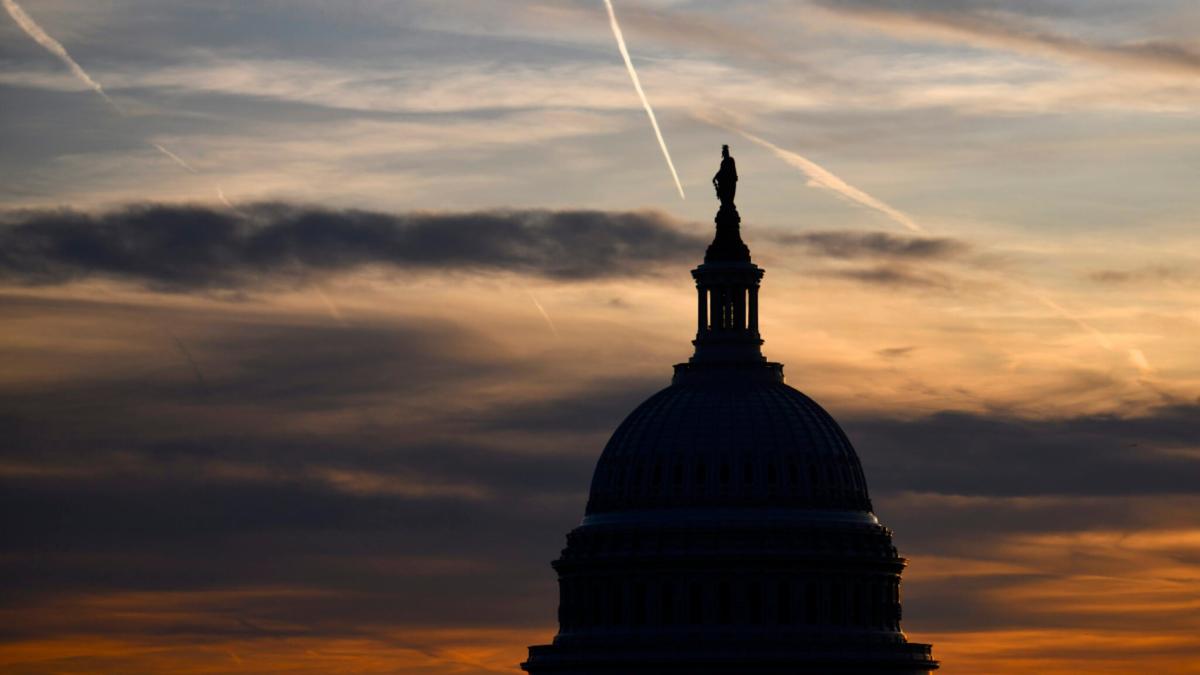Welcome to the June edition of A Capitol View
The United States Advanced Ceramics Association has unanimously elected SMI COO Ken Wetzel as its new executive director to lead the trade group at a critical juncture for a domestic industrial base that underpins hypersonic weapons, microelectronics, and nuclear power.
Ken succeeds SMI’s former president Glen Mandigo, who for the past dozen years has expanded the association, advocated for additional federal funding, and played a key role in elevating some of the challenges faced by USACA’s 42 members, which range from Fortune 100 companies to small manufacturers.
The transition took place at USACA’s annual spring meeting, organized by SMI on May 23 in Washington. Attendees heard from Stan Bouslog of NASA’s Johnson Space Center; Christina Chao from the Office of the Secretary of Defense; Chris Haines from Army Research Laboratories; and Huijuan Dai from DOE’s Advanced Materials and Manufacturing Technologies Office (AMMTO). Discussions focused on pending legislation and federal programs central to members’ growth plans.
“I look forward to building upon Glen’s achievements working with the membership to advocate for prioritization and investment in these advanced materials so critical for helicopter and aircraft engines, missiles and munitions, civilian nuclear power generation, and more,” Wetzel said.
USACA and its members are playing a central role in addressing some of the glaring industrial base shortfalls that have emerged in the wake of COVID-19 and the war in Ukraine, where advanced ceramics are critical components of many of the weapons and platforms included in allied military aid.
“We will work together to promote more awareness of the ceramics industry, so it is not an afterthought for policymakers or taken for granted in the acquisition process for renewable energy and military applications,” Wetzel added.
“I thank the many volunteer association leaders from industry and the staff from SMI and Bayside Materials for all their hard work these past years to grow the association and overcome challenges during the pandemic,” added Mandigo, now SMI senior VP. “USACA continues to be the leading voice in Washington for the high-performance ceramics industrial base, which produces materials that are critical for national defense, energy efficiency, semiconductor, and other manufacturing processes.”
For more information on USACA, contact SMI Analyst William Willkomm at william@strategicmi.com
BUDGET
LET’S MAKE A DEAL: The Fiscal Responsibility Act of 2023 that passed the House and Senate raises the debt limit, places a freeze on most non-military spending for two years, and slows defense spending.
The two-year framework, negotiated by President Joe Biden and House Speaker Kevin McCarthy to avoid a default, caps the budget for national defense at $886 billion for fiscal 2024, a 3.3 percent increase over the current year. Spending would then increase in fiscal 2025 to $895 billion. But the growth does not keep pace with inflation.
Some other highlights include greater work requirements for food stamp recipients and mandating the return of unused COVID funding, which the Congressional Budget Office estimates would reduce the deficit by $1.5 trillion over a decade.
The framework was adopted despite opposition from some of the GOP’s far-right flank, who charge it doesn’t require enough spending cuts, and concerns from hawks in both parties who want a bigger Pentagon budget and have vowed to push for changes during the appropriations process.
DEFENSE
BACK TO BASICS: Negotiations over the debt ceiling package delayed the annual appropriations process, which is now poised to resume.
“The House funding process will kick off with a committee review of the Defense bill before July Fourth, providing a look at how the committee funds Member’s priority requests,” SMI VP Maria Bowie explains. “The Senate is expected to follow with their process starting in July after they return from the holiday recess, which is on track with what had previously been projected.”
TECH TRANSITION: The Defense Department has published a National Defense Science & Technology Strategy, which calls for “fostering a more vibrant defense innovation ecosystem” and “accelerating the transition of new technology into the field.”
The document emphasizes the 14 critical technology areas laid out last year by Pentagon research chief Heidi Shyu, who said the new strategy “helps us make carefully crafted decisions that bolster our comparative advantages rather than engaging in wasteful technology races.”
International push: DoD is also requesting congressional authority to contribute funds to NATO’s Defense Innovation Accelerator of the North Atlantic, according to a new legislative proposal.
The NATO outfit, modeled after the Pentagon’s Defense Advanced Research Projects Agency, seeks to advance dual-use technologies for the alliance.
The proposal calls for $12.5 million to be invested in FY24, and $8.8 million annually through FY28.
Related: DOD Industrial Base Senior Advisor Erin Simpson to Lead Joint Production Accelerator Cell, via ExecutiveGov
LIFE SCIENCES
TIPS AND TRICKS: SMI VP Dr. Travis Taylor and Director Evan Dorner kicked off a series of webinars in partnership in May with trade association Bio North Texas on how to most effectively engage with the federal government.
The first episode focused on communicating with government partners, leveraging allies, and the ingredients of successful grant applications. Future webinars will focus on the appropriations process in Congress and policy changes that companies need to know to navigate the federal space.
To learn more, reach out to Travis and Evan at travis@strategicmi.com and evan@strategicmi.com.
Related: BioSonics Part of Congressional Delegation, via BioSonics.
ENERGY
PERMITTED: The debt ceiling package calls for reforms to the environmental permitting process by cutting down on NEPA review timelines and encouraging interagency coordination on the execution of environmental documents. But lawmakers have also begun discussions on a more comprehensive reform package for energy projects.
The GOP-led House passed a bill in March that would allow the EPA administrator to waive Clean Air Act requirements for certain critical energy resource facilities and prohibit the President from restricting or delaying new oil, gas, coal and mineral exploration project permits.
Meanwhile, Senators Manchin, Carper, Barrasso and Moore-Capito have all introduced distinct proposals to streamline lengthy review processes for energy projects.
The divides: Republicans want to help facilitate more fossil fuel projects and oil and gas leases, while Democrats want to accelerate the approval of transmission powerlines and clean energy projects that were funded by the Bipartisan Infrastructure Law and Inflation Reduction Act. Passed last year.
EV FUNDING: The Department of Energy’s Vehicle Technologies Office has released its annual program-wide solicitation, totaling $99.5 million, for research and development efforts across a range of electric vehicle technologies.
The agency is placing a premium on proposals that prioritize the Biden administration’s environmental justice principles, including directing a significant share of new investments in clean energy to “disadvantaged communities who are marginalized, underserved, and overburdened by pollution.”
Concept papers are due June 26.
EMERGING TECHNOLOGY
PHASED APPROACH: The Department of Commerce’s Economic Development Administration has announced the first phase of its Regional Technology and Innovation Hubs, or Tech Hubs, program.
The program, established by the CHIPS & Science Act, will make awards to consortia that advance research, demonstrations and workforce development in key emerging technologies. The legislation set aside $500 million for at least 20 regional hubs this fiscal year.
The National Science Foundation released a request for information for input on a roadmap for its Technology, Innovation, and Partnerships (TIP) Directorate, which was also created by the CHIPS Act.
Some focus areas: AI and machine learning; high performance computing and semiconductors; robotics, automation and advance manufacturing; biotechnology and genomics; and advanced energy technologies, materials and composites.
SETTING THE STANDARD: To carry out the CHIPS Act, the White House also published its National Standards Strategy for Critical and Emerging Technology, which is aimed at safeguarding U.S. commercial technologies and leading on international standards.
The National Institute for Standards and Technology has set up a portal to track the implementation of the new strategy.
DOMESTIC MANUFACTURING
GOING THE DISTANCE: SMI client New Balance will break ground June 5 on an expansion of its Skowhegan, Maine, production center, one of the footwear manufacturer’s five U.S. facilities.
On hand will be Sens. Angus King and Susan Collins, Governor Janet Mills, and other state and local officials and partners.
This $65 million investment in construction and capital equipment will increase New Balance’s U.S. production capabilities and add 200 new manufacturing jobs.
READING ROOM
NDIA Hypersonics Supply Chain Report
NDIA Defense Industrial Base Vitality Outlook 2023
CLIENTS IN THE NEWS
A better bridge across the ‘valley of death’ by PSI, Inc. CEO Bill Marinelli,’ via Defense News.








